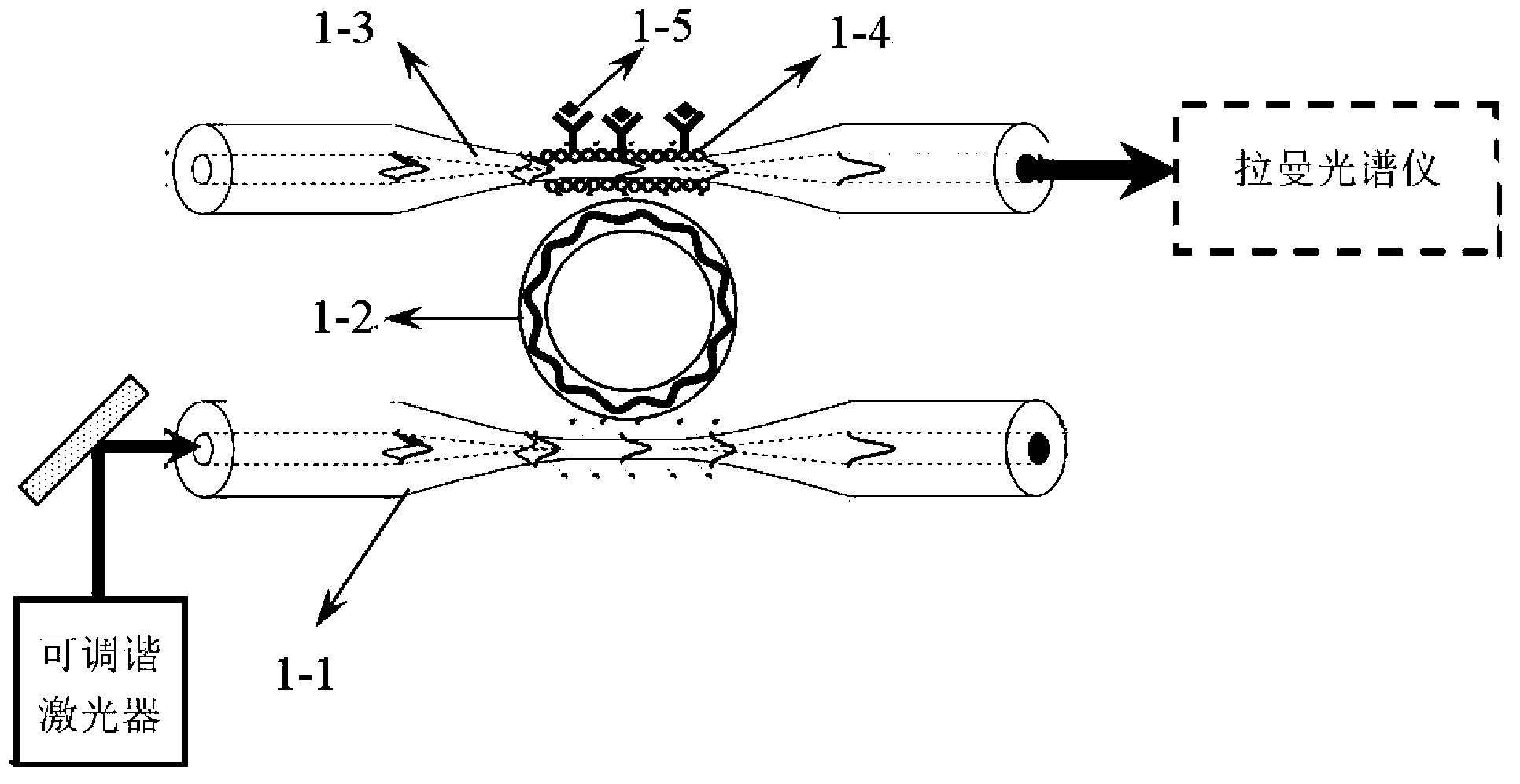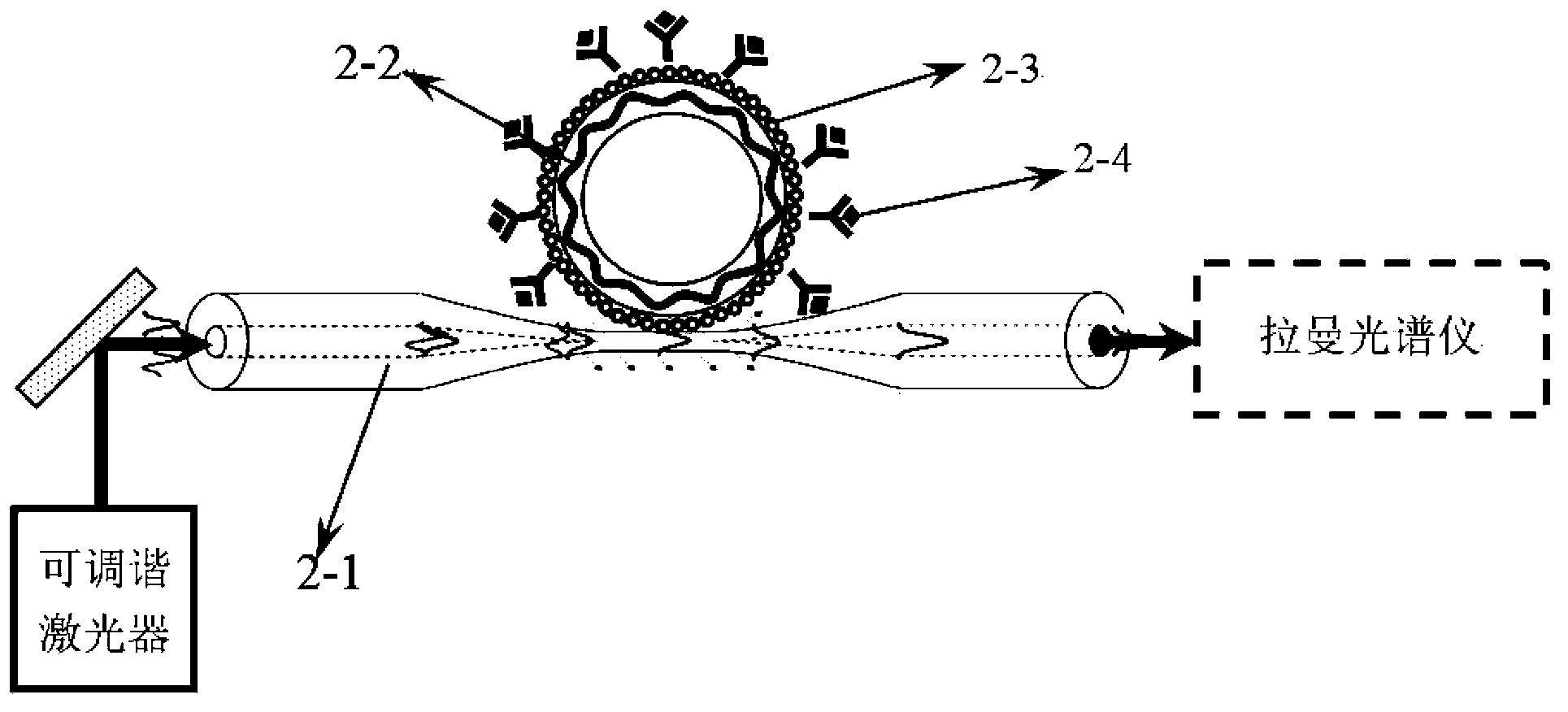Near-field Raman biosensor based on echo wall mode
A biosensor and whispering gallery mode technology, applied in the field of biological and chemical analysis and sensing, can solve the problems of low signal-to-noise ratio, sample damage, low optical coupling efficiency, etc., to improve signal strength and signal-to-noise ratio, improve Enhancement factor, the effect of improving the signal-to-noise ratio
- Summary
- Abstract
- Description
- Claims
- Application Information
AI Technical Summary
Problems solved by technology
Method used
Image
Examples
Embodiment 1
[0029] Such as figure 1As shown, the near-field Raman biosensor based on the whispering gallery mode of the present invention includes a tunable laser, an excitation tapered optical fiber 1-1, a microsphere resonant cavity 1-2, an output tapered optical fiber 1-3, and a metal nanoparticle 1 -4; one end of the excitation tapered fiber 1-1 is aligned with the output window of the tunable laser, and the microsphere resonator 1-2 is located at the taper region of the excitation tapered fiber 1-1 and the output tapered fiber 1-3, The metal nanoparticles 1-4 are adsorbed on the surface of the microsphere resonant cavity 2-2, and the measured biological sample 1-5 is adsorbed on the metal nanoparticles 1-4.
[0030] The excitation tapered optical fiber 1-1 and output tapered optical fiber 1-3 can be single-mode, multi-mode optical fiber or tapered optical waveguide. The microsphere resonator is a quartz microsphere or a high-Q plane microcavity. The metal nanoparticles 1-4 are gold...
Embodiment 2
[0033] Such as figure 2 As shown, the near-field Raman biosensor based on the whispering gallery mode of the present invention includes a tunable laser, a coupling tapered fiber 2-1, a microsphere resonant cavity 2-2, a metal nanoparticle 2-3; a coupling tapered fiber 2 One end of -1 is aligned with the output window of the tunable laser, the microsphere resonator 2-2 is located at the tapered region of the coupling tapered optical fiber 2-1, and the metal nanoparticles 2-3 are adsorbed on the microsphere resonator 2-2 On the surface, the measured biological sample 2-4 is adsorbed on the metal nanoparticles 2-3.
[0034] The light emitted by the tunable laser enters the coupling tapered fiber 2-1. When the light passes through the tapered region, it is coupled with the near-field of the microsphere resonator 1-2 through the evanescent field, and the light is coupled into the microsphere resonator 2-2. At a series of specific wavelengths (low-order and high-order resonance wa...
PUM
 Login to View More
Login to View More Abstract
Description
Claims
Application Information
 Login to View More
Login to View More - R&D
- Intellectual Property
- Life Sciences
- Materials
- Tech Scout
- Unparalleled Data Quality
- Higher Quality Content
- 60% Fewer Hallucinations
Browse by: Latest US Patents, China's latest patents, Technical Efficacy Thesaurus, Application Domain, Technology Topic, Popular Technical Reports.
© 2025 PatSnap. All rights reserved.Legal|Privacy policy|Modern Slavery Act Transparency Statement|Sitemap|About US| Contact US: help@patsnap.com


